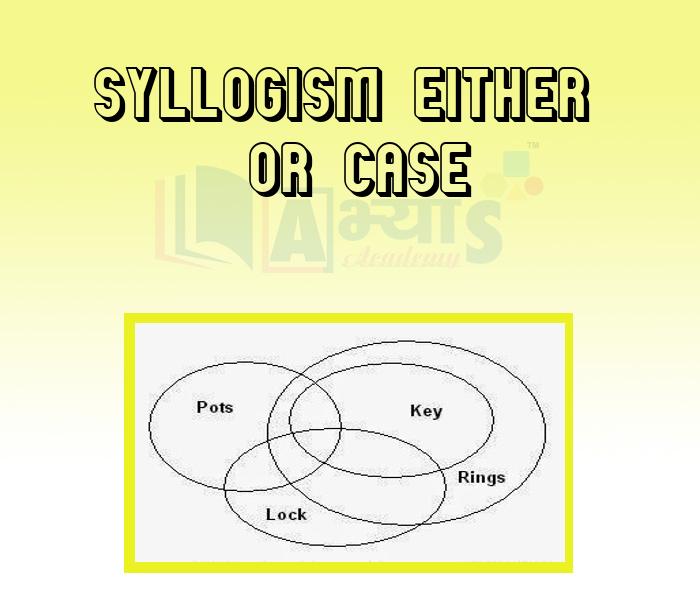Syllogism Either or Case







Syllogism Either or Case
Syllogism - Either or Case:
Illustration:: In the question below, two statements are given followed by Conclusions numbered I and II. The candidate has to assume all the statements to be true even if they seem to be at variance from the commonly known facts and then decide which of the given two Conclusions logically follows from the information given in the statements and mark the option best suited.
Statement :
In the question below, two statements are given followed by Conclusions numbered I and II. The candidate has to assume all the statements to be true even if they seem to be at variance from the commonly known facts and then decide which of the given two Conclusions logically follows from the information given in the statements and mark the option best suited.
Statements:
I. Some bed are table.
II. All chair are table.
. Conclusions:
I. At least some bed are chair.
II. Some bed are definitely not chair.
A. Only Conclusion I follows B. Only Conclusion II follows C. Either Conclusion I or II follows D. Neither Conclusion I nor II follows
Answer : C
In the question below, two statements are given followed by Conclusions numbered I and II. The candidate has to assume all the statements to be true even if they seem to be at variance from the commonly known facts and then decide which of the given two Conclusions logically follows from the information given in the statements and mark the option best suited. Statement: I. No colour is a paint. II. No colour is a varnish. I. Some varnish are paint. II. No varnish are paint. | |||
| Right Option : C | |||
| View Explanation | |||
In the question below, three statements are given followed by Conclusions numbered I and II. The candidate has to assume all the statements to be true even if they seem to be at variance from the commonly known facts and then decide which of the given two Conclusions logically follows from the information given in the statements and mark the option best suited. Statement : I. Some ball are bat. II. No bat are toy. III. All doll are toy. Conclusion : I. Some ball are toy. II. No ball are toy. | |||
| Right Option : D | |||
| View Explanation | |||
In the question below, two statements are given followed by Conclusions numbered I and II. The candidate has to assume all the statements to be true even if they seem to be at variance from the commonly known facts and then decide which of the given two Conclusions logically follows from the information given in the statements and mark the option best suited. Statements: I. Some trees are plants. II. All bushes are plants. I. At least some trees are bushes. II. Some trees are definitely not bushes. | |||
| Right Option : C | |||
| View Explanation | |||
Students / Parents Reviews [10]
My experience with Abhyas is very good. I have learnt many things here like vedic maths and reasoning also. Teachers here first take our doubts and then there are assignments to verify our weak points.

Shivam Rana
7thAbhyas Methodology is very good. It is based on according to student and each child manages accordingly to its properly. Methodology has improved the abilities of students to shine them in future.

Manish Kumar
10thIt was a good experience with Abhyas Academy. I even faced problems in starting but slowly and steadily overcomed. Especially reasoning classes helped me a lot.

Cheshta
10thMy experience with Abhyas academy is very good. I did not think that my every subject coming here will be so strong. The main thing is that the online tests had made me learn here more things.

Hiya Gupta
8thI have spent a wonderful time in Abhyas academy. It has made my reasoning more apt, English more stronger and Maths an interesting subject for me. It has given me a habbit of self studying

Yatharthi Sharma
10thBeing a parent, I saw my daughter improvement in her studies by seeing a good result in all day to day compititive exam TMO, NSO, IEO etc and as well as studies. I have got a fruitful result from my daughter.

Prisha Gupta
8thA marvelous experience with Abhyas. I am glad to share that my ward has achieved more than enough at the Ambala ABHYAS centre. Years have passed on and more and more he has gained. May the centre flourish and develop day by day by the grace of God.

Archit Segal
7thAbout Abhyas metholodology the teachers are very nice and hardworking toward students.The Centre Head Mrs Anu Sethi is also a brilliant teacher.Abhyas has taught me how to overcome problems and has always taken my doubts and suppoeted me.

Shreya Shrivastava
8thOne of the best institutes to develope a child interest in studies.Provides SST and English knowledge also unlike other institutes. Teachers are co operative and friendly online tests andPPT develope practical knowledge also.

Aman Kumar Shrivastava
10thMy experience was very good with Abhyas academy. I am studying here from 6th class and I am satisfied by its results in my life. I improved a lot here ahead of school syllabus.
